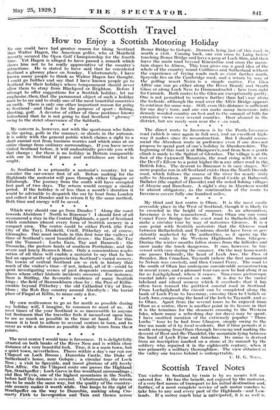My third and last centre is Oban. It is the
most easily accessible place in the West of Scotland, though it is likely to be crowded in the height of summer. As an alternative, Inveraray is to be remembered. From Oban one can cross. Connel Ferry Bridge for the coast road to Ballachulish, anti make a circular tour by way of notorious Glencoe. It is a sore point with Scottish motorists that the Glencoe road between Ballachulish and Tyndrum should have been so per• sistently neglected by the authorities, as it opens up the shortest route to the Western Highlands from Glasgow.- During the winter months fallen stones from the hillsides and snow make the track dangerous. It can, however, be till- versed with care during the summer. On the way homewards one passes Dalmallv the head of Loch Awe, the Pass of Brander, Ben Cruachan, Taynuilt (where the first monument to. Nelson was erected), and then Connel Ferry. The road to the south of Oban has undergone considerable reconstruction in recent years, and a pleasant tour can now be had along it as far as Lochgilphead, where it ceases. Numerous picturesque coastal inlets are crossed so route. It is due to the varied lakeland and island scenery which it overlooks that it has often been termed the prettiest coastal road in Scotland. From Lochgilphead the circuit can be completed along the bank of Loch Fyne to Inveraray, crossing then to Cladich oil• Loch Awe, compassing the head of the loch to Taynuilt, and sii to Oban. Apart from the several tours to be enjoyed from Obari as a centre, there is another point in its favour in that it is the terminus for the steamers crossing to the Western Isles, where many a refreshing day (or days) may be spent. I have omitted mention of the extremely popular " Three Lochs " tour to be had from Glasgow, simply owing to the free use made of it by local residents. But if time permits it is worth returning from Oban through In and making the descent of Rest-and-Be-Thankful, the mountain lying between the head of Loch Fyne and Arrochar.' Its name is derived from an inscription marked on a stone at its summit by the soldiery who repaired it in the eighteenth century, when it was primarily a military thoroughfare. The view obtained of the valley one leaves behind is unforgettable.
C. H. G. Nam.








































 Previous page
Previous page